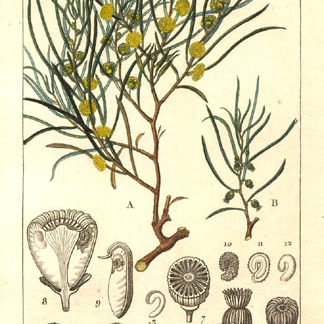Shrub or small tree to 5 m, usually with a bushy crown. Trunk stout, with corky bark. Branchlets smooth. Leaves filiform-terete, acute, 2–7 cm long, soft, pale green; stipules narrow, less than 0.5 mm long, golden orange or brown. Flowers solitary, axillary. Male flowers: pedicels 3–7 mm long, recurved; calyx 1–2 mm long, divided to ¼–½ into obtuse lobes with scarious margins; stamens 40–100 in 4–7 rows, sometimes less. Female flowers: pedicels 5–7 mm long, rarely shorter, reflexed or spreading; calyx 1.5 mm long, divided to ½ into obtuse lobes with scarious margins; carpels 17–33; stigmas 1.5–2 mm long, slender, ±papillose, shortly united; disc corona-like. Fruiting carpels obovate to semi-circular, 4–6 mm long, the keel not hardened; seed almost horizontal or oblique, oblong, 1.5 mm long, rugose; aril small.
More
A medium sized shrub. It grows 3-5 m high and spreads 1-3 m wide. The crown is bushy. The bark is thick and corky. The leaves are 2-7 cm long by 0.1 cm wide. They are soft, light green and often wavy. Flowers occur singly in the axils of leaves. The male flowers are 0.6 cm across and have 40-100 stamens in 4-7 rows. The female flowers are 0.5 cm across. They are 17-33 carpels. The fruit are 0.8 cm across.
Grows oncoastal dunes, sandy rises and desert dunes, in shrubland and low woodland;rarely by granite outcrops.
More
It grows on sand dunes near the coast and sand ridges inland.


